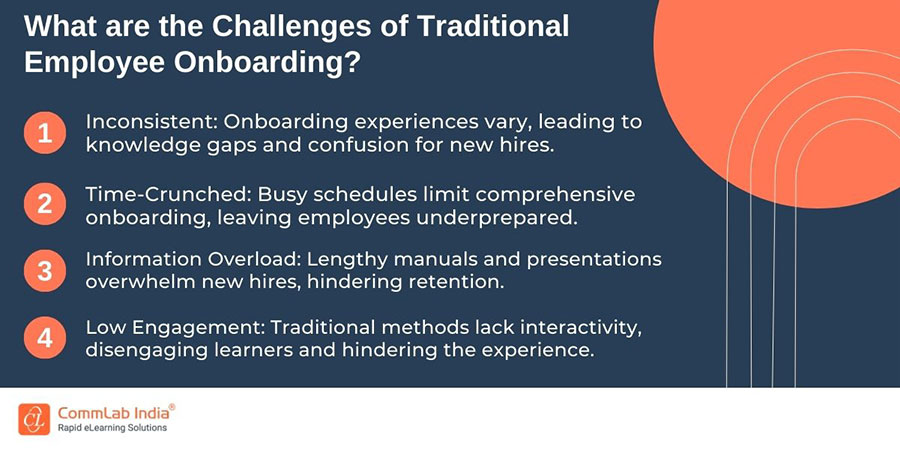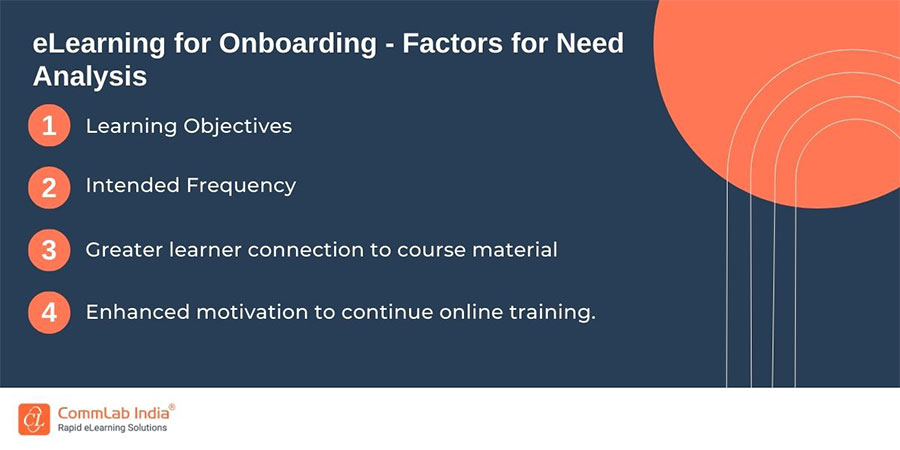How Can eLearning Help Streamline New Employee Onboarding?

The first few weeks at a new job are crucial. New hires are eager to learn, contribute, and feel like valued members of the team. However, traditional onboarding processes can often be clunky, time-consuming, and leave employees feeling overwhelmed. This is where eLearning steps in as a powerful tool to streamline new employee onboarding, leading to a smoother transition, increased engagement, and a faster path to productivity.
Is eLearning the key to streamlining your new employee onboarding?
Yes, eLearning can be a game-changer for onboarding new hires. Here's how:
- Scalability & Consistency: Deliver consistent information anytime, anywhere.
- Improved Engagement: Interactive modules make learning fun and engaging.
- Faster Time to Productivity: Equip new hires with essential skills upfront.
- Reduced Costs: Develop and deliver eLearning modules more cost-effectively
The Challenges of Traditional Employee Onboarding
Onboarding new employees is a multifaceted process that goes beyond paperwork and logistics. It's about setting the tone for a positive employee experience, fostering a sense of belonging, and equipping new hires with the knowledge and skills they need to succeed. However, traditional onboarding methods often face several challenges:

eLearning: Why is it a Game-Changer for New Employee Onboarding?
eLearning offers a dynamic and adaptable solution for addressing challenges associated with traditional onboarding. By leveraging technology, eLearning can transform onboarding by offering several key benefits:
Scalability and Consistency: eLearning modules are accessible anywhere, anytime, ensuring consistent information delivery for all new hires regardless of location or trainer availability.
Improved Engagement: Interactive modules, simulations, gamified elements, and multimedia content can make learning more engaging and enjoyable for new hires. Learning becomes less passive and more like an interactive exploration, fostering better knowledge retention.
Faster Time to Productivity: eLearning can deliver essential information and skills upfront, allowing new employees to ramp up faster and become productive members of the team sooner.
Flexibility: eLearning programs can be tailored to specific roles, departments, or even individual learning styles, providing a more personalized onboarding experience.
Accessibility: eLearning modules can be developed to be accessible for individuals with disabilities, ensuring a more inclusive onboarding experience.
→ Download Now: Online Learning for Corporate Training [eBook]
How to Build a Winning eLearning Onboarding Program? [Implementation Tips]
While eLearning offers significant benefits, it's important to design and implement your program thoughtfully. Here are some key steps to ensure your eLearning program effectively streamlines new employee onboarding:
Needs Assessment: Before developing any modules, conduct a thorough needs assessment to identify the knowledge, skills, and behaviors (KSBs) new hires need for success in their specific roles. This includes company culture, policies and procedures, essential software skills, and job-specific technical knowledge.

Content Development: Develop engaging and well-structured modules that cover essential information in an easily digestible format. Consider using multimedia elements like videos, infographics, and interactive exercises to enhance learning. Break down complex topics into smaller, manageable chunks to avoid overwhelming new hires.
Learning Objectives: Clearly define learning objectives for each module. This will help measure the effectiveness of your program and ensure new hires are acquiring the necessary knowledge and skills.
Microlearning: Consider using microlearning techniques by creating shorter, focused modules. This allows learners to easily access information in bite-sized chunks and complete training at their own pace.
Variety is Key: Don't rely solely on text-based modules. Incorporate a variety of learning activities and assessments like case studies, quizzes, simulations, and branching scenarios.
Integration with Other Onboarding Activities: Don't view eLearning as a replacement for other onboarding elements. Use it to complement existing programs like shadowing, mentorship, team introductions, and one-on-one meetings.
Feedback and Evaluation: Continuously gather feedback from new hires and stakeholders through surveys, focus groups, and completion rates. Ask questions like:
- Was the content clear and engaging?
- Were the learning objectives achieved?
- Did the eLearning program help them feel prepared for their role?
Use this feedback to refine your eLearning program, ensuring it continues to meet the needs of your new hires.
Measuring the Success of Your eLearning Onboarding Program
How do you know if your program is truly successful? Here are some key metrics to track and analyze:
Completion Rates: Track the percentage of new hires who complete the entire eLearning program. While completion rates alone don't guarantee effectiveness, a consistently low completion rate might indicate issues with content engagement or accessibility.
Knowledge Retention: Assess new hires' understanding of key concepts through quizzes, knowledge checks, or scenario-based assessments embedded within the eLearning modules. This helps ensure they're retaining the information covered in the program.
Time to Productivity: Measure the time it takes for new hires to reach a predetermined level of performance in their roles. An eLearning program that effectively equips new hires with the required knowledge and skills should lead to a faster time to productivity.
Employee Satisfaction: Conduct surveys or exit interviews to understand new hires' perceptions of the onboarding experience, including their satisfaction with the eLearning program. Did they find it helpful and engaging?
Engagement Metrics: Analyze various engagement metrics within the eLearning platform, such as time spent on modules, completion rates for individual modules, interactions with activities and assessments, and learner progress. This data can reveal areas where learners might be losing focus or struggling, allowing you to refine the program for better engagement.
How to Use Quantitative Metrics to Evaluate and Improve Your eLearning Programs [Video]
BONUS: Taking eLearning Onboarding to the Next Level
Here are some additional tips for taking your eLearning onboarding program to the next level:
Gamification: Incorporate gamification elements like points, badges, and leaderboards to enhance engagement and motivation.
Mobile Learning: Make your eLearning modules mobile-friendly to allow learners to access them on their smartphones or tablets for increased flexibility.
Social Learning: Consider incorporating social learning elements like discussion forums or collaborative activities to encourage interaction and knowledge sharing among new hires.
Personalized Learning Paths: Develop personalized learning paths based on individual needs and roles. This allows new hires to focus on the information most relevant to their specific job functions.
Artificial Intelligence (AI): Explore the potential of AI-powered learning experiences that can adapt to individual learning styles and provide personalized feedback.
Wrapping Up
eLearning is a powerful tool that can revolutionize your new employee onboarding process. By leveraging its benefits, you can streamline onboarding, improve knowledge retention, and accelerate new hires' path to productivity. Continuously evaluate your eLearning program, gather feedback, and adapt it to meet the evolving needs of your organization and your workforce. By doing so, you can create a positive and engaging onboarding experience that sets new hires up for success from day one.
Want to explore eLearning or other online services for your corporate training? Here's an eBook to guide you:



![Exploring 10 Custom eLearning Solutions for Corporate Training[Infographic]](https://blog.commlabindia.com/hubfs/blogs/custom-elearning-solutions-corporate-training-infographic.jpg)
![Mastering Onboarding Training – A Guide for Instructional Designers [Video]](https://blog.commlabindia.com/hubfs/blogs/onboarding-training-instructional-design-guide-video.jpg)
